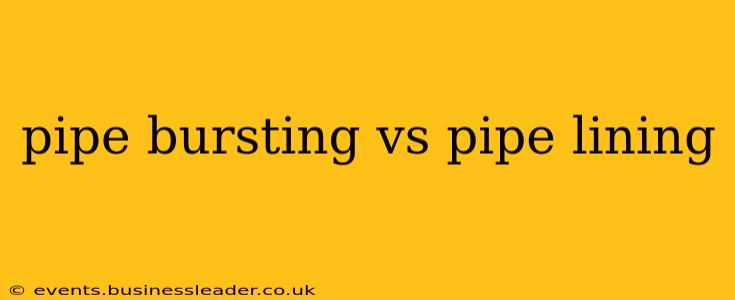Choosing between pipe bursting and pipe lining can be a daunting task, especially when faced with the need for underground pipe repair or replacement. Both methods offer trenchless solutions, minimizing disruption and cost compared to traditional excavation, but they differ significantly in their approach and suitability for various situations. This comprehensive guide will break down the key differences between pipe bursting and pipe lining, helping you make an informed decision for your specific needs.
What is Pipe Bursting?
Pipe bursting is a trenchless technology used to replace existing underground pipes without extensive excavation. A bursting head, pulled through the existing pipe, fractures the old pipe while simultaneously installing a new, larger diameter pipe in its place. This method is particularly effective for replacing damaged or deteriorated pipes that are beyond repair.
Advantages of Pipe Bursting:
- Larger diameter replacement: Allows for upgrading to a larger diameter pipe, increasing flow capacity.
- Durable results: The new pipe is installed directly into the ground, offering superior long-term strength and stability.
- Suitable for various pipe materials: Can be used to replace various materials, including cast iron, PVC, and clay pipes.
Disadvantages of Pipe Bursting:
- More disruptive than pipe lining (in certain aspects): While trenchless, the process still requires access points at both ends of the pipe run.
- Higher initial cost: Generally more expensive than pipe lining, particularly for shorter pipe lengths.
- Not suitable for all soil conditions: May be challenging in rocky or heavily compacted soil.
What is Pipe Lining?
Pipe lining, also known as cured-in-place pipe (CIPP) lining, involves inserting a flexible liner into the existing pipe. The liner is then inflated and cured, creating a new pipe within the old one. This method is ideal for repairing minor damage, cracks, or leaks in existing pipes.
Advantages of Pipe Lining:
- Less disruptive: Requires smaller access points compared to pipe bursting, minimizing disruption to landscaping and traffic.
- Lower initial cost: Generally less expensive than pipe bursting, especially for smaller projects.
- Suitable for various pipe materials: Can be used to rehabilitate a wide range of pipe materials.
Disadvantages of Pipe Lining:
- Does not increase pipe diameter: The new liner will maintain the original pipe diameter; it doesn't allow for increasing flow capacity.
- Shorter lifespan compared to bursting (in certain cases): While durable, the liner's lifespan may be shorter than a completely replaced pipe, depending on the materials and conditions.
- Limited suitability for severely damaged pipes: May not be effective for pipes with significant structural damage or major offsets.
Pipe Bursting vs. Pipe Lining: Which is Better?
The best method depends on several factors, including:
- Severity of pipe damage: For severely damaged or deteriorated pipes, pipe bursting is often the better option. Pipe lining is more suitable for pipes with minor damage or leaks.
- Desired pipe diameter: If an increase in pipe diameter is needed to improve flow capacity, pipe bursting is the only suitable choice.
- Budget: Pipe lining typically involves a lower upfront cost, whereas pipe bursting is generally more expensive.
- Site conditions: Soil conditions, access limitations, and the overall project scope will influence the feasibility of each method.
Frequently Asked Questions (FAQs)
How long does pipe bursting take?
The time required for pipe bursting varies depending on the length of the pipe, soil conditions, and other factors. It's best to consult with a professional for an accurate timeline.
How long does pipe lining take?
Similar to pipe bursting, the time needed for pipe lining depends on several factors. Generally, it takes less time than pipe bursting for shorter runs.
Which method is more environmentally friendly?
Both methods are considered more environmentally friendly than traditional excavation, as they minimize soil disturbance and waste generation. However, the specific environmental impact can vary based on the materials used and project specifics.
What are the common signs that I need pipe repair or replacement?
Signs of potential problems include low water pressure, slow drains, recurring clogs, foul odors, water leaks, or visible cracks in the pipe.
What is the typical lifespan of pipes after bursting or lining?
The lifespan of a pipe after bursting or lining depends heavily on the materials used, soil conditions, and the quality of the work. Consult a professional for an accurate assessment of the expected longevity.
By carefully considering these factors and consulting with a qualified contractor, you can make an informed decision and choose the optimal trenchless pipe repair method for your specific needs. Remember to always seek professional advice before undertaking any major plumbing project.
